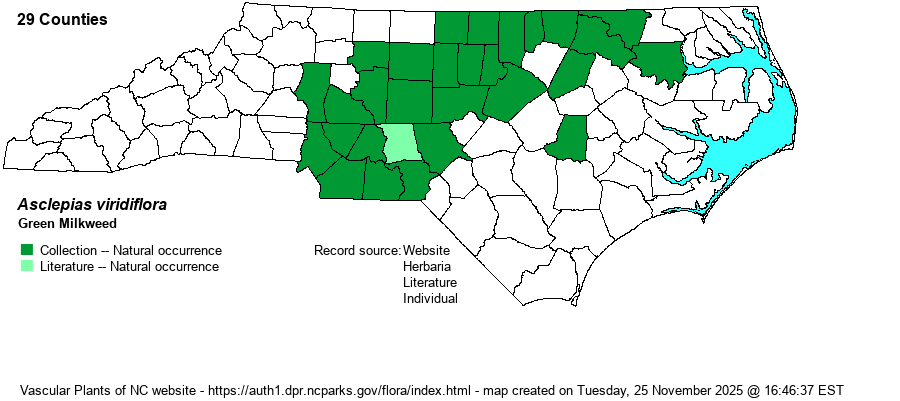| Author | Rafinesque | |
| Distribution | Present over the eastern and central Piedmont, west only to Forsyth, Iredell, and Mecklenburg counties. Also present in the northwestern portion of the Coastal Plain, noted only to Bertie and Wayne counties. Not found in the Mountains and western Piedmont (at least yet), despite it occurring in TN and farther west.
This is primarily a Midwestern and Great Plains species, though ranging east to CT and the FL Panhandle. It is mostly absent from the Atlantic Coastal Plain province. | |
| Abundance | Infrequent in the central and eastern Piedmont, and rare to uncommon in the northwestern Coastal Plain. Despite it not being common, it has been collected from most counties within this broad NE-SW band in the state. | |
| Habitat | This is a milkweed species that strongly favors circumneutral (high pH) soil, in dry conditions. It grows in glades and barrens, woodland borders, openings in dry woods, in powerline clearings, and in old fields -- typically in full sun (as it is often considered as a "prairie plant" species). In fact, it is present in quite a few Piedmont "natural areas" that protect rare natural communities (glades, barrens, etc.) and rare "prairie" plants. |
| Phenology | Blooms from June to August, and fruits from August to September. | |
| Identification | This is an easily overlooked milkweed owing to its small size and pale green flowers. It has a fairly slender and unbranched stem, growing only to about 1-1.5 feet tall. It has several pairs of opposite leaves, which are quite variable in shape from plant to plant. In general, the leaves are widely elliptic to oblong, with a rounded tip, and about 2-3 inches long and about 1-wide wide; leaves tend to be ascending and not spreading. From several upper leaf nodes grow the flower clusters, each a very dense ball about 1-inch across. The flowers are dull green to yellow-green to olive-green, with the five petals strongly reflexed, such that each flower is "tube-like", about 1/2-inch long. An inexperienced observer might not even recognize the "green ball" with the many "tubes" of flowers as a milkweed, or at least will wonder "when the flowers will open up and be fully in bloom"! However, when a leaf is broken at its base next to the stem, the white milky sap will clinch the identification. This species has somewhat weedy tendencies, growing in powerline clearings and other dry and often disturbed ground, as long as the soils are fairly high in pH. However, when you spot this species, take the time to search the general area for other scarce plant species. | |
| Taxonomic Comments | None
| |
| Other Common Name(s) | Green Comet Milkweed, Short Green Milkweed, Green-flowered Milkweed. In Eastern states, the species is generally known as Green Milkweed. Farther west, where there are a few other milkweeds with green flowers, a more descriptive name is used, such as the alternative names listed above. | |
| State Rank | S4 | |
| Global Rank | G5 | |
| State Status | | |
| US Status | | |
| USACE-agcp | | |
| USACE-emp | | |

